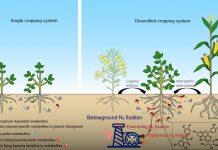Zhu TB Zhang JB Cai ZC. The contribution of nitrogen transformation processes to total N(2)O emissions from soils used for intensive vegetable cultivation. Plant and Soil 2011 343(1-2): 313-327. (IF 2.773 农林科学,一区)
Abstract
The rapid expansion of intensively farmed vegetable fields has substantially contributed to the total N2O emissions from croplands in China. However to date the mechanisms underlying this phenomenon have not been completely understood. To quantify the contributions of autotrophic nitrification heterotrophic nitrification and denitrification to N2O production from the intensive vegetable fields and to identify the affecting factors a 15N tracing experiment was conducted using five soil samples collected from adjacent fields used for rice-wheat rotation system (WF) or for consecutive vegetable cultivation (VF) for 0.5 (VF1) 6 (VF2) 8 (VF3) and 10 (VF4) years. Soil was incubated under 50% water holding capacity (WHC) at 25°C for 96 h after being labeled with 15NH4NO3 or NH415NO3. The average N2O emission rate was 24.2 ng N kg−1 h−1 in WF soil but it ranged from 69.6 to 507 ng N kg−1 h−1 in VF soils. Autotrophic nitrification heterotrophic nitrification and denitrification accounted for 0.3–31.4% 25.4–54.4% and 22.5–57.7% of the N2O emissions respectively. When vegetable soils were moderately acidified (pH 6.2 to ≥ 5.7) the increased N2O emissions resulted from the increase of both the gross autotrophic and heterotrophic nitrification rates and the N2O product ratio of autotrophic nitrification. However once severe acidification occurred (as in VF4 pH ≤ 4.3) and salt stress increased both autotrophic and heterotrophic nitrification rates were inhibited to levels similar to those of WF soil. The enhanced N2O product ratios of heterotrophic nitrification (4.84‰) autotrophic nitrification (0.93‰) and denitrification processes were the most important factors explaining high N2O emission in VF4 soil. Data from this study showed that various soil conditions (e.g. soil salinity and concentration of NO3– or NH4+) could also significantly affect the sources and rates of N2O emission.







